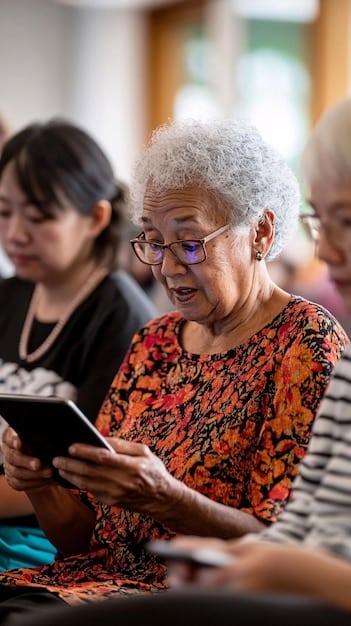Digital Divide in the US: Affordable Internet Access Programs

Digital Divide in the US: Bridging the Gap with Affordable Internet Access Programs is crucial for ensuring equal access to opportunities. Several initiatives aim to provide affordable internet access, addressing the disparities in today’s digital landscape.
The internet has become an essential utility in the 21st century, yet a significant portion of the US population remains disconnected. But what exactly is the digital divide? And more importantly, what can be done to solve it?
The good news is organizations and Government are launching programs to bridge the Digital Divide in the US: Bridging the Gap with Affordable Internet Access Programs, offering affordable internet access to those who need it most. From low-cost plans to community initiatives, there are solutions to explore.
Understanding the Digital Divide in the US
The digital divide refers to the gap between those who have access to modern information and communication technologies (ICT) and those who do not. This divide can be observed in different aspects, including access to the internet, computers, and digital literacy skills.

Several factors contribute to the digital divide, such as income, education, geographic location, and age. Understanding them is crucial to implementing effective solutions.
The consequences of the digital divide are far-reaching, affecting education, employment, healthcare, and civic engagement. Without adequate access to digital resources, individuals and communities are at a significant disadvantage.
Key Factors Contributing to the Digital Divide
Let’s explore the primary elements that widen the digital gap.
- Income Disparities: Lower-income households often cannot afford internet subscriptions or devices.
- Educational Attainment: Lack of digital literacy skills hinders effective use of technology, perpetuating the divide.
- Geographic Location: Rural areas often lack the infrastructure necessary for high-speed internet access.
- Age: Older adults may face challenges in adopting new technologies.
The digital divide presents a series of challenges for individuals and communities alike.
The Far-Reaching Consequences of Digital Disparities
Here are some ways they are impacting individuals and groups:
- Educational Impact: Students without internet access at home struggle to complete assignments and participate in online learning.
- Employment Opportunities: Many jobs require digital skills, limiting opportunities for those without access.
- Healthcare Access: Telemedicine and online health resources are inaccessible to those without internet.
- Civic Engagement: Digital tools are increasingly used for accessing government services and participating in civic processes.
Various initiatives and programs are in place to bridge this divide and it is vital to be aware of the opportunities available.
In conclusion, the digital divide has far-reaching consequences, affecting vital aspects of life. Addressing this issue through targeted programs and initiatives is crucial for creating a more inclusive and equitable society.
Affordable Internet Access Programs: A Solution
Affordable internet access programs play a critical role in bridging the Digital Divide in the US: Bridging the Gap with Affordable Internet Access Programs. These programs aim to lower the cost barrier, making internet service accessible to low-income households.
There are several types of affordable internet access programs available.
Types of Affordable Internet Access Programs
Many options exist to connect individuals with the world via digital assistance.
- Federal Programs: The Affordable Connectivity Program (ACP) offers monthly discounts on internet service for eligible households.
- State Programs: Some states have their own initiatives to provide low-cost internet options.
- Provider Programs: Many internet service providers (ISPs) offer discounted plans for low-income customers.
- Nonprofit Initiatives: Organizations like EveryoneOn and PCs for People provide affordable devices and internet access.
Eligibility criteria generally include income level, participation in government assistance programs, and residency requirements.
How to Qualify for Affordable Internet
Meeting the requirements can bring individuals into the digital age.
- Income Level: Households with incomes at or below a certain threshold (often 200% of the federal poverty level) may qualify.
- Participation in Assistance Programs: Enrollment in programs like SNAP, Medicaid, or SSI can make households eligible.
- Residency Requirements: Some programs are limited to residents of specific states or areas.
Affordable internet access programs offer numerous benefits, including increased access to education, employment, healthcare, and essential services. By removing financial barriers, these programs help level the playing field and promote digital equity.
In summary, affordable internet access programs are essential for addressing the digital divide. These programs offer various pathways for eligible households to obtain low-cost or free internet service. By reducing financial barriers, society can create a more inclusive and equitable digital landscape.
Federal Initiatives: The Affordable Connectivity Program (ACP)
The Affordable Connectivity Program (ACP) is a federal initiative designed to help low-income households afford internet service. It is one of the most significant efforts to bridge the Digital Divide in the US: Bridging the Gap with Affordable Internet Access Programs.
The ACP provides eligible households with a monthly discount of up to $30 on their internet bill. Households on Tribal lands can receive up to $75 per month.
Key Features of the ACP
The ACP aims to make internet service more affordable by providing:
- Monthly Discount: Up to $30 off the monthly internet bill for eligible households.
- Tribal Lands Benefit: Up to $75 off the monthly internet bill for households on qualifying Tribal lands.
- One-Time Device Discount: A one-time discount of up to $100 for a laptop, tablet, or desktop computer (with a co-payment of $10-$50).
To be eligible for the ACP, households must meet certain criteria, such as having an income at or below 200% of the federal poverty level or participating in certain government assistance programs.
How to Apply for the ACP
Applications consist of the following requirements:
- Online Application: Households can apply through the ACP website.
- Documentation: Applicants must provide documentation verifying their eligibility, such as proof of income or participation in qualifying programs.
- Enrollment: Once approved, households must enroll with an internet service provider participating in the ACP.
The ACP increases access to essential online resources and opportunities, promoting greater digital inclusion for low-income communities. This federal initiative plays a crucial role in bridging the digital divide and ensuring that more Americans can benefit from internet connectivity.
In conclusion, the Affordable Connectivity Program is a vital resource in the effort to bridge the digital gap. With its focus on providing affordable internet access, the ACP helps ensure that more households can access essential online resources and opportunities, promoting digital inclusion for all.
The Role of Local Communities in Bridging the Gap
Local communities play a vital role in bridging the digital divide by implementing targeted solutions that address the unique needs of their residents. Community-based initiatives are essential to Digital Divide in the US: Bridging the Gap with Affordable Internet Access Programs.

Local initiatives often include:
Types of Community-Based Initiatives
Let’s see how people are being helped on a local level.
- Community Centers: Providing free internet access, computer training, and digital literacy workshops.
- Libraries: Offering public computers, internet access, and digital skills programs.
- Schools: Implementing programs to provide students with laptops, tablets, and internet access both at school and at home.
To maximize their impact, community-based initiatives leverage partnerships between local organizations, businesses, and government agencies.
Building Partnerships for Digital Inclusion
Collaborations are the key to expanding access.
- Local Organizations: Working with community groups to identify needs and deliver targeted services.
- Businesses: Partnering with local businesses to provide funding, equipment, or volunteer support.
- Government Agencies: Collaborating with city, county, and state agencies to secure funding and resources for digital inclusion efforts.
Success stories from local communities demonstrate the impact of these initiatives. For example, in Seattle, the Seattle Digital Equity Initiative has provided free internet access and digital literacy training to thousands of residents, significantly reducing the digital divide.
In summary, local communities are at the forefront of efforts to address the digital gap, implementing targeted solutions. By leveraging partnerships and community-based initiatives, cities and towns across the country are making significant strides in bridging the digital divide.
Looking Ahead: The Future of Affordable Access
The future of affordable internet access depends on continued innovation, collaboration, and investment in digital inclusion efforts. Addressing the Digital Divide in the US: Bridging the Gap with Affordable Internet Access Programs requires a multi-faceted approach.
Emerging technologies are promising ways to expand affordable internet access.
Innovations in Internet Technology
How can tech help bridge this divide?
- Low Earth Orbit (LEO) Satellites: Providing high-speed internet to remote and rural areas.
- 5G Technology: Offering faster and more reliable wireless internet options.
- Wi-Fi Expansion: Increasing the availability of free or low-cost public Wi-Fi hotspots.
Sustained investment in digital infrastructure and literacy programs is crucial.
The Importance of Continued Investment
Why we need to keep focusing on investment:
- Infrastructure Development: Expanding broadband infrastructure to underserved areas.
- Digital Literacy Programs: Equipping individuals with the skills they need to use technology effectively.
- Device Access: Ensuring that everyone has access to affordable computers, tablets, and other devices.
Policy recommendations for promoting digital equity include:
- Expanding ACP Funding: Ensuring that the Affordable Connectivity Program has sufficient resources to continue providing support.
- Incentivizing Provider Participation: Encouraging internet service providers to offer affordable plans and participate in digital inclusion initiatives.
- Promoting Digital Literacy: Supporting programs that provide digital skills training to people in lower income brackets and remote areas..
In conclusion, the future of affordable access hinges on our collective efforts to drive innovation, invest in infrastructure and education, and implement policies that promote digital equity. Continuous innovation, collaboration, and strategic investments are essential to bring about a more connected society.
| Key Point | Brief Description |
|---|---|
| 💡Digital Divide in the US | Unequal access to internet and technology among different demographics. |
| 💰 ACP Program | Affordable Connectivity Program offering internet discounts to eligible households. |
| 🤝 Community Initiatives | Local programs and partnerships providing internet access and digital literacy. |
Frequently Asked Questions
The digital divide refers to the gap between those who have access to digital technology and those who do not. Bridging this gap is crucial to ensure fair access of information and resources.
The ACP provides eligible households with a monthly discount on their internet bill, helping low-income families afford internet service, and promoting connectivity.
Eligibility criteria typically include income level, participation in assistance programs, and residency requirements. Those who meet the criteria are often able to receive assistance.
Community centers provide free internet, computer training, and digital literacy programs, making technology more accessible to local residents and boosting the community.
Low Earth Orbit (LEO) satellites and 5G technology are expanding access to remote and rural areas. Furthermore expanding public Wi-Fi is helping to improve connectivity everywhere.
Conclusion
Bridging the Digital Divide in the US: Bridging the Gap with Affordable Internet Access Programs is essential for a creating society of equals. Through federal initiatives, community-based programs, and technological innovations, it’s possible to achieve.
As technology continues to evolve, it is important to consider digital equity. By working together, we can create a fully connected society that is fair for everyone.





